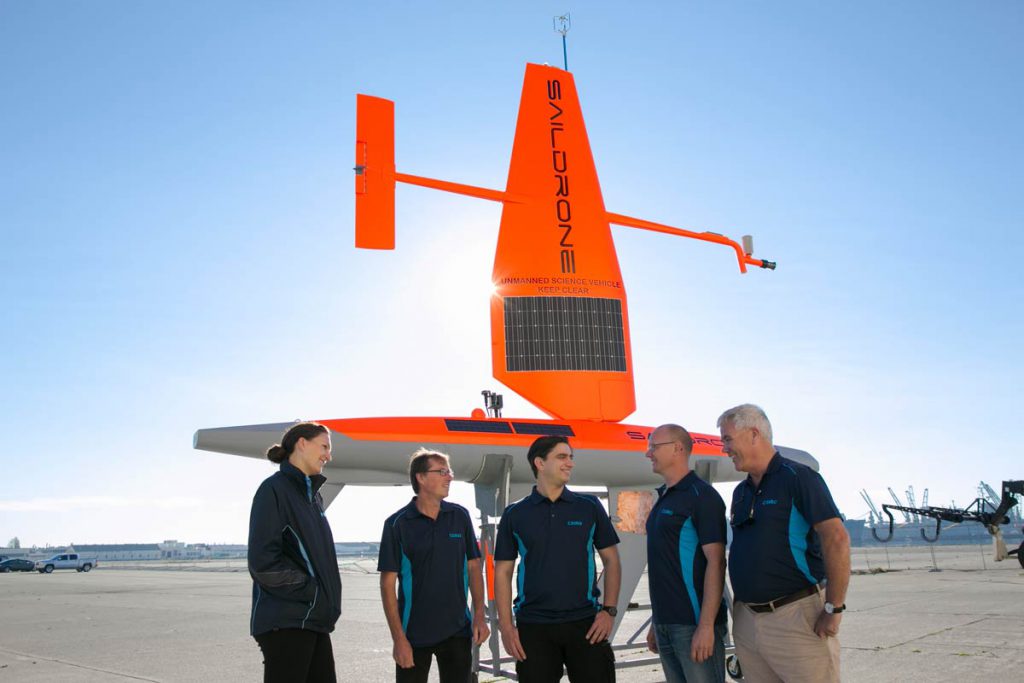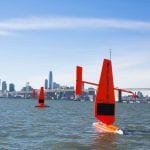Australian Scientists Use Cutting Edge Sailboat Drone Fleet to Monitor Ocean and Climate Change
With the oceans covering over 70% of our planet, it’s no surprise that an understanding of it is an important factor in understanding climate change.
In Australia, a country that is entirely surrounded by ocean, a group of scientists from the country’s scientific research organisation, CSIRO, unveiled this weekend a fleet of autonomous ocean-going sailboats to go where many have not gone before.
The partnership, which was announced in January, is with San Francisco-based startup Saildrone, whose distinctive orange sailing drones are also assisting the National Oceanic and Atmospheric Administration (NOAA) team to study the El Niño–Southern Oscillation, the cycling global temperature and rainfall pattern that is a result of warm surface waters moving around the equatorial Pacific every few years.
The Australian scientists’ mission is to collect data about sea-surface temperature, salinity, ocean carbon and lifeforms, while also collaborating on the development of Saildrone technology. Beginning with providing the drones with specialised sensors designed to measure ocean carbon, they will continue to develop a platform for the next generation of marine and climate technologies.

CSIRO Oceans and Atmosphere Team with one of the Saildrones | CSIRO
“One of the big challenges in looking at global climate change and global variability is a lack of observations,” explained Andreas Marouchos, leader of the CSIRO Research Group. “The partnership with Saildrone and CSIRO is quite unique in that it provides opportunities for scientists who would not otherwise be able to go to sea to make very critical ocean observations.”
Departing from the Tasmanian capital of Hobart before Easter, the Saildrones form part of a larger program to test and validate technologies that will inform future carbon capture and storage (CCS) projects.
Speaking with CSIRO earlier this month, Australian Saildrone founder and CEO Richard Jenkins explained how the saildrones will be able to reach areas of ocean that can otherwise be inaccessible due to the tyranny of distance.
“The Saildrone works with combination of wind and solar using this unique patented wing, we harness the wind energy to push the vehicle along and then we use solar to charge the batteries and that runs the computers on board,” he said.
So, it doesn’t consume anything while it goes along and so it can stay at sea almost indefinitely.”
The drones will carry payloads to add very specialised capabilities to the scientific research.
“Saildrones are capable of making a wide range of scientific measurements both of the atmosphere immediately above the ocean and information from the ocean itself. That includes salinity sensors, temperature sensors, atmospheric sensors,” Tim Ryan, Senior Research Scientist at CSIRO, elaborated.
“What we’re bringing to the table is some very dedicated, specific instrumentation measuring the carbon both in the water and immediately above the water surface.”
By understanding the carbon fluxes on the ocean they will better understand climate change. Ryan added, “That’s fundamental to understanding the uptake of carbon which goes into global climate models.”
- Source: CSIRO
- Source: CSIRO
Andreas Marouchos, Research Group Leader, CSIRO, explained that additionally, sonic equipment will allow better understanding of ocean lifeforms.
“We’re also equipping the systems with a scientific echo sounder which will insonify the water column, basically ping the water column with an acoustic pulse which allows us to look at the biota, the fish, the critters in the water column as well as potential bubble seeps coming from the ocean floor,” he said.
“We have never had an opportunity like this before,” CSIRO scientist Dr Bronte Tilbrook said.
“By combining advanced sea-faring sensing technology, we will be able to capture more data over longer period of time and provide credible information back to government, industry and the community.”
Saildrone so far has covered over 100,000 nautical miles in oceanic regions stretching from the Gulf of Mexico, the Bering Sea, even sailing a high risk mission into Hurricane Joaquin in the extreme conditions of the North Atlantic in 2015.
More recently, in an ongoing partnership with NOAA, Saildrones have been used to monitor fur seal colonies on St. Paul Island in Alaska.
“Our partnership with Saildrone and the Australian Government builds on our investment in marine research infrastructure for the nation and supports CSIRO’s strategy for cutting-edge research which facilitates the monitoring and mitigation of climate change,” CSIRO Chief Executive Dr Larry Marshall said.
“Industry partnerships are critical to innovation and are at the heart of our mission as Australia’s national science agency.
“The fleet of Saildrones may be small in stature, but their ability to autonomously monitor and collect rich streams of data at sea for up to twelve months makes them truly unique in terms of the value they can deliver industry, the research community and ultimately our biggest customer – the nation.”





















